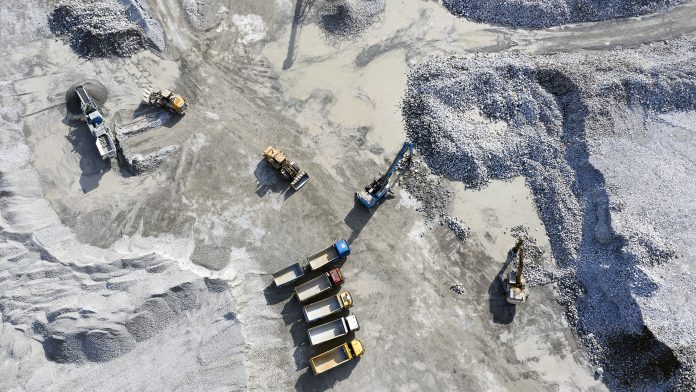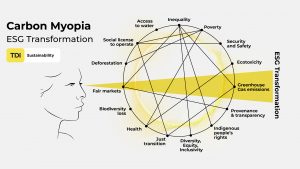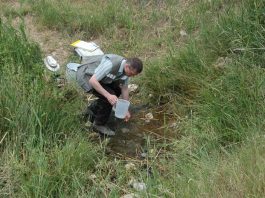Assheton Stewart Carter, CEO of TDi Sustainability, outlines the five key issues that mining companies must consider to remain compliant with new ESG regulations.
A silent compliance tsunami is about to hit corporate shores in the form of new environmental, social, and governance (ESG) regulations in the mining sector. The need to equip your organisation with a bigger, future-proof perspective has never been more pressing. Five key emergent issues threaten to weaken the strength of current mining efforts if teams do not step back and adjust their strategies now.
With an ESG staff member on every team, and climate change a permanent fixture on every company agenda, the pressure to deliver actionable results can lead to increasingly large amounts of box-ticking. It is no longer enough to make promises – independently adjudicated standards must be met to prove and track your commitments. However, there is a very real danger that, with heads down following the current paper trail, industry is missing clear warning signs appearing on the rapidly looming horizon.
You must now evaluate whether your company is considering issues beyond the immediate. From early next year, new expectations of companies are being set by the EU and some of its members that will raise the bar for the rest of the global community; such as increased ESG regulations in mining sector. A tipping point is approaching to force organisations into establishing a deeper, wider-reaching set of practices, and it will not be long before currently accepted narrower mitigation strategies are seen to fall short.
We foresee five critical issues where taking a myopic approach today may pose dangerous risks in future for our clients. At TDi Sustainability, we monitor current and pending regulations and survey scores of companies along the supply chain to gauge the concerns that companies should be aware of, so that we can help them stay one step ahead of what is coming next. Based on our experience creating research for organisations like the International Lithium Association and National Mining Association, as well as major global corporations across big tech, the automotive and luxury, a silent compliance tsunami is about to hit your shores.
Companies currently embarking on laser-focused sustainability plans to meet the industry-specific climate change targets set by investors, regulators or standard-setters are at risk of missing the wider topics at play relative to their own activities, as well as those within their supply chains. Though seemingly further off and less pressing, the importance of these tangential elements cannot be ignored. Below are the five issues that all companies upstream or downstream of the mining and minerals sector need to consider broadening their strategy for now.
Look beyond 3T&G
Known in the industry as ‘3T&G’, tin, tungsten, tantalum, and gold are currently the minerals of focus in EU and United States conflict minerals regulation, requiring companies to ensure good governance in their responsible sourcing strategies. However, future EU and member state regulations will widen the remit beyond specific ‘conflict minerals’ to include supply chain due diligence, not only for all materials and minerals but also for all goods and services. If your organisation’s ESG strategy currently only examines the sourcing of 3T&G, it is crucial that you begin to expand the focus to accommodate a deeper understanding of your full supply chain.
Supporting our clients with this mammoth task is what we do at TDi Sustainability; gathering insights, generating in-depth reports, and creating a suite of tools to help organisations obtain a full picture of their supply chains. One of our industry-leading services, designed to make it as easy as possible for companies to access global networks of up-to-date information, is a unique online information platform called Materials Insights. This online public access tool is backed by our in-house allegations and analysis software and database, and can be used by companies to deepen their understanding of and mitigate against risks in supply chains.
Step outside the conflict countries
To date, interpretations of responsible sourcing frameworks for conflict minerals focus on the Democratic Republic of the Congo and surrounding countries of the Great Lakes regions. The EU’s approach to conflict-affected and high-risk areas (CAHRAs), however, is not restricted to the Great Lakes, and incorporates an increasingly large number of countries with different levels and types of risk, so too has the way in which companies are expected to define their ‘red flag’ strategies. New legislation shifts away from country-specific analysis to demand a fresh methodology that can be applied to any potential geographical area.
Much more sophisticated regional risk assessment tools will be needed to create nuanced understandings of the layers of risk within different jurisdictions. Developed by our team at TDi Sustainability to make it as easy as possible for our clients to build a full global picture of their supply chains, the AIRS Tool (Alert Index for Responsible Sourcing) provides up-to-date ratings on conflict, law, human rights, and environment issues on a country-by-country basis. Beyond this, TDi Sustainability delves deeper into sub-regional risk assessments, and adjusts these risks for different minerals, metals, trading routes and social and environmental impacts.
Move from risks to root causes
Weighing up and mitigating against potential risks along the supply chain has been a key feature of both regulations and corporate ESG strategies in mining, but the core mindset behind this approach is rapidly shifting. It is no longer enough to show how you avoid problems. New regulations will be expecting companies to take an active role in creating and supporting solutions to the root causes of those problems, through technology and skills transfer and positive investments that make an impact on the ground.
Where changes are inevitable – for example, where the transition from small-scale artisanal mining (ASM) to larger-scale industrial mining threatens the livelihoods of millions of ASM workers – companies will be asked to take an active role in facilitating a just transition to support and sustain existing workers throughout the evolution of the supply chain. Through TDi Sustainability’s Impact Facility initiative, we make it easy for companies to start making a difference on the ground, at the upstream end of mineral sourcing, through impact investment, development grants, value chain development and multi-stakeholder partnerships.
Start to prove your good governance
When it comes to laying out strategy around management responsibilities, corporate ESG standards in mining have forced organisations to focus more on the mitigation of practical risks, through analysis of operations, incidents and impacts at sites and their surrounding communities. In the very near future, a company’s management strategies will also need to show equal transparency around the way it ensures good governance. This will require thinking beyond the operational running of sites to show how softer qualities of transparency, traceability, diversity, equality, and inclusion are also being upheld across an organisation and its supply chains. To discuss how TDi Sustainability can support you in building a comprehensive good governance strategy tailored to your organisation’s unique needs, get in touch at info@tdi-sustainability.com.
Expand your ESG regulations and human rights lists
If your organisation has been used to ticking off its ESG and human rights responsibilities according to prescribed standards, it is time to think bigger. Your company’s current list may have included comprehensive reviews on topics such as water use, biodiversity, Indigenous Peoples’ rights (for which TDi Sustainability has developed a helpful open access tool) the potential threat of continuing local conflict, ensuring you are maintaining your or your suppliers’ social license to operate. Each focused field of vision comes with a huge paper trail of compliance and consideration. However, future trends suggest that ticking topics off a specified list will no longer be sufficient. Organisations will soon be asked to overturn every stone and look at every element of sourcing and social responsibilities related to ESG regulations in mining, to prove all threads of the web that links them to suppliers and their community are as sustainable and ethical as possible. Get in touch to find out more about how TDi Sustainability can help you develop a 360° plan for your organisation.
In the immediate term, a confusion of new standards addressing the core issues outlined above is about to be unleashed by the EU, and the biggest question for any ESG manager will be how to go about organising them into a manageable order that will both meet the necessary targets and provide longer-term preparation for additional future legislation. For the many organisations with a single member of staff wearing the ESG cap, this might seem like an insurmountable task. Across all sectors in the mining and metals supply chain – although we find it to be especially the case for the companies we work with at TDi Sustainability who depend on the mining industry, whether upstream at the coalface (or lithium, cobalt, nickel, gold, diamond-face, etc.) of extraction or downstream in manufacturing and software – it can be difficult for in-house ESG specialists to step back from the many concerns already pressing within their existing industry to keep a 360° view on all the other continually evolving issues within the landscape of sustainability and social governance.
Stepping back is the only option if a company is to survive in this new, compliance-heavy era ahead of us. At TDi Sustainability, we urge our clients to think not only about the issues directly related to their company and industry now but also to be looking ahead strategically, with a longer-term view. We find that putting more initial time into a broader, more considered ESG regulations mining plan creates fewer surprises and enables faster progress down the line. Being proactive rather than reactive is all about seeing the full picture – from every angle – in order to weigh up short-term and long-term risks and opportunities, always with a view to prioritised action.
We find that helping our clients think through this prioritisation process is the best thing they can do. It is a go-slow-to-go-fast tactic, mapping out the next five to ten years as thoroughly as possible, so that later efforts are not wasted unpicking myopic early reactions. At TDi Sustainability we encourage our clients to create a fully rounded picture of:
- The public issues landscape today;
- The temporal horizon, considering where the core issues will be heading in future;
- Which of these issues are most important to your business; and
- What influence your company has to play with, to determine how best you can make an impact.
For companies to survive the compliance overload and thrive, it is essential that this larger vision is mapped out. It is essential to ward off risks and remain on top of new standards, as well as staking out a position to equip you for long-term success. Knowledge and foresight are protection. By making better choices and investments towards a more sustainable and socially responsibly future now, you create a resilient business foundation, and equip yourself with the best positioned vessel to sail smoothly through any storms ahead.
Please note, this article will also appear in the tenth edition of our quarterly publication










